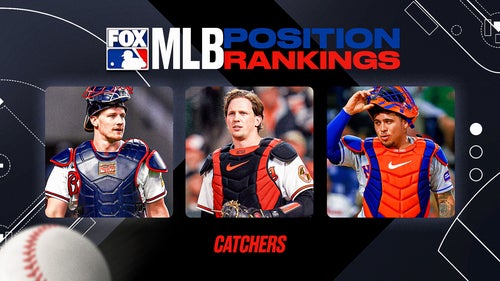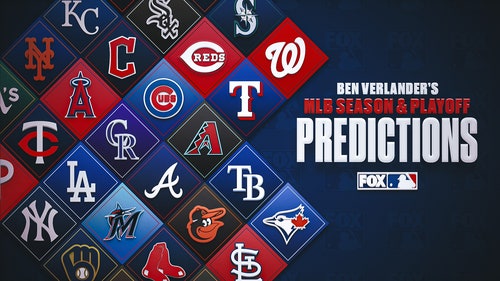
Why MLB's best young stars will strike it wildly rich in 'resetting of the market'
The Cleveland Indians tried to extend the contract of shortstop Francisco Lindor before Opening Day, but not even dangling what one source said was a package around $100 million did the trick.
The Chicago Cubs made runs at extending several of their young players this winter, including third baseman Kris Bryant, but according to one source, every one of those efforts “got nowhere.”
We are living in an age of the greatest 25-and-under slugging stars in the free-agent era. Here’s the catch for the clubs: When so many players are this good and this young, we are looking at a new paradigm in placing a value on that talent. For instance, what is the value right now of one free agent year of Bryant in 2022? That’s why the Indians, the Cubs and other clubs with elite young players have been unable to buy out potential free-agent years.
In putting together my all-25-and-under team last month, this jumped out: Only two of the 12 players are locked up through at least one free-agent year—Angels outfielder Mike Trout and Rangers second baseman Rougned Odor, the latter of whom just signed this spring. Teams typically want control of at least two free-agent years when they extend young players. The younger the player when he is free-agent eligible, the more valuable those years become.

Much has been written about Free Agent Armageddon that is expected to come after next season, when Nationals outfielder Bryce Harper, Orioles third baseman Manny Machado, Blue Jays third baseman Josh Donaldson and Dodgers ace Clayton Kershaw (who has an opt-out) could be free agents. But the real mother lode could come after the 2021 season, when the free-agent class could include these players: Lindor (who would be 28 in his first free-agent year), Bryant (30), Astros shortstop Carlos Correa (27), Dodgers shortstop Corey Seager (28), Cubs shortstop Addison Russell (28) and Cubs outfielder Kyle Schwarber (29). All entered this year with less than two years of service time.
In fact, Harper and Machado may be partly responsible for why none of the greatest young stars are eager to sell their free-agent years yet.
Said one agent, “A re-setting of the market is coming with Harper and Machado, especially given their ages at free agency. So it’s safe to assume the value of free-agent years is going to go up, and it’s not crazy to think that number is going to start with a four.”
Are we actually close to valuing free-agent years at $40 million for the most elite players? On the same day three years ago—March 28, 2014—the Angels bought out three free-agent years in the prime of Trout's career for about $34 million per year while the Tigers signed first baseman Miguel Cabrera to a deal that starting next year will pay him at least $30 million for each of the next six years. That November the Marlins bought out 10 free-agent years of Giancarlo Stanton at an average price of $29.5 million per year.

By 2018, and in the auction atmosphere of an open market, will Harper’s free-agent years be worth an 18% premium on Trout’s money, or $40 million annually? If so, how difficult is it for players such as Lindor and Bryant to sign away their free-agent value five years in advance when they know a market surge is coming?
Greg Genske, the agent for Correa, recently told FanRag Sports that his client would “never” sign an extension. Correa backtracked from that position, but did say he would not consider an extension once he becomes arbitration eligible after next season.
David Meter, the agent for Lindor, said about the Indians’ failed attempt at an extension, “It’s just one of those things we’ll look at on a year-by-year basis. I don’t think it’s very productive to draw a line in the sand.”
Said one club executive, “Right now it’s only mid-level players and players with some of the smaller, boutique agencies who are saying yes to extensions.”
Agent Scott Boras, whose clientele includes Harper, Bryant, Seager and Russell, will have a large say in re-setting the market.
“That old $110 million [extension] offer from about five years ago has grown stale,” Boras said.
Boras predicted that among the top seven young players of the potential free agent Class of 2021-22, only “about three will come close to free agency.” He said among the advantages of his agency is that he carries no debt (so he is under no pressure to derive quick income from player extensions, he said); that he has the experience of negotiating “$7 billion in contracts”; and that he has more information than other agencies and even most clubs because he employs “25 people year-round” to provide research and to develop statistical models that define value.
Boras has been criticized for steering his clients away from extensions and toward free agency. In defense against that reputation, Boras, who negotiated a seven-year, $175 million extension for Nationals pitcher Stephen Strasburg last year, said, “I have no motives other than the best interests of the player.
“My first rule [on extension offers] is that I tell the player, ‘Do not look at the team as if they’re trying to steal you. They’ve made the decision that is the right decision. The question is, What is the investment worth? What is the value?’”

When the Cubs approached Boras about extending Bryant, for instance, Boras said he and Chicago president Theo Epstein “were on the same page” as far as the fit of Bryant with the team, but made no traction on value.
“It’s no different negotiating with him on Jacoby Ellsbury and all the other deals we’ve done,” Boras said, referring to Ellsbury’s time in Boston, when Epstein was GM. Ellsbury signed a series of one-year deals before signing a seven-year contract with the Yankees as a free agent. “Theo does not settle on certain things. He offers a very limited range. You’ve got to give up an option year, a free agent year and he can move you whenever he wants to move you.”
Extensions that buy up free-agent years are rare for players with less than two years service time. Andrelton Simmons signed one of those deals, getting $58 million over seven years. Bigger deals are more common after two years of service as arbitration starts to loom, such as the ones for Trout and Giants catcher Buster Posey ($159 million for eight years).
Clubs like extensions because they build in cost certainty, especially when the extensions can buy up free-agent years. Players who sign extensions like them because they provide security and peace of mind. In most cases of star players, the tradeoff for that security and peace of mind is accepting something below maximum market value, which typically comes in free agency, when teams can bid on players’ services.

For instance, Mariners second baseman Robinson Cano, using the power of free agency, has signed contracts worth $297.8 million. Another second baseman, the Red Sox' Dustin Pedroia, has signed two extensions with Boston worth $140 million.
“Alex Rodriguez turned down $70 million and $120 million after his fourth and fifth seasons [in Seattle],” Boras said about his former client, who eventually signed a free-agent contract with the Rangers worth $240 million. “The idea of what free agent years are worth has always been re-evaluated. . . . Rule number one in baseball is that no team has ever gone broke. Rule number two is that there’s never been an owner who didn’t make money when he sold the team. And rule number three is that there are no recessions in baseball.”
This article originally appeared on











































































































































